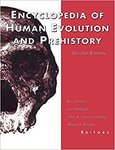US
AU
By Eric Delson, Ian Tattersall, John Van Couvering and Alison S. Brooks (Editors)
780 pages, 2nd edition, published Nov 23, 2004
Amazon's Description:
Praise for the first edition: "The most up-to-date and wide-ranging encyclopedia work on human evolution available."—American Reference Books Annual "For student, researcher, and teacher…the most complete source of basic information on the subject."—Nature "A comprehensive and authoritative source, filling a unique niche…essential to academic libraries…important for large public libraries." —Booklist/RBB
eBook is free at time of posting. Please check price before buying.



Also available for free.
Although I believe it belongs in the fiction section.
And on the 5th day…
https://www.pitt.edu/~dash/genesis01-03.html